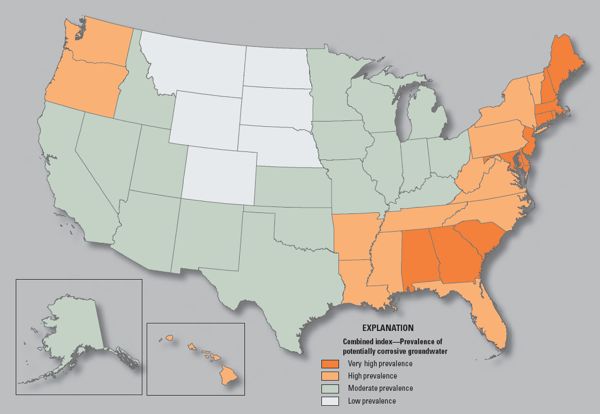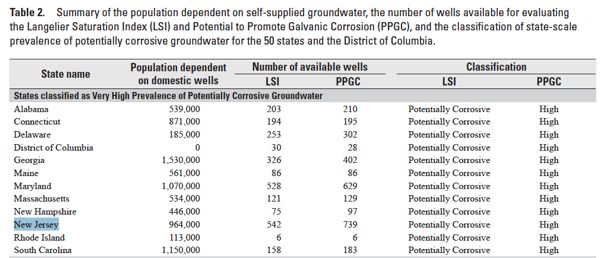NJ DEP Downplays High Lead Risks
DEP Lead Sampling Methods Mask Lead Levels
DEP private well sampling protocol requires flushing, conflicts with US EPA methods
Do 66% – 72% of NJ water supply systems served by highly corrosive groundwater implement corrosion control programs? Do the same percentage of private residential wells? Doubtful.
The United States Geological Survey (USGS) just released a national study “Potential Corrosivity of Untreated Groundwater in the United States” that finds NJ groundwater is highly corrosive, among only a handful of states with a “very high prevalence” of corrosive groundwater.
The study suggests that NJ faces high risks of leaching of lead from pipes and plumbing into drinking water (see USGS press release):
Two indicators of potential corrosivity were combined to determine that corrosive groundwater occurs in all 50 states and the District of Columbia. Corrosive groundwater, if untreated, can dissolve lead and other metals from pipes and plumbing fixtures.
“The corrosivity of untreated groundwater is only one of several factors that may affect the quality of household drinking water at the tap,” said Don Cline, USGS associate director for Water. “Nevertheless, it is an essential factor that should be carefully considered in testing for water quality in both public and private supplies nationwide.”
Note that USGS study considered the risks of corrosive groundwater on BOTH private wells and public water supplies.
NJ had the nation’s 4th largest number of domestic supply wells that were highly vulnerable (USGS estimated 964,000 people depended on those well – see Table 2 below) – USGS found from 66 – 72.3% of those wells corrosive *See Table 3).
I previously wrote about high lead levels found in NJ’s Private Well Testing Act program data:
Here is the lead data, from DEP’s Private Well Testing Act (PWTA) Report (2008):
Lead samples in homes – A total of 5,523 (11%) of the homes had lead levels above the previous Ground Water Quality Standard of 10 μg/l. This number increased to 9,368 (18%) of homes that had lead levels above the new Ground Water Quality Standard of 5 μg/l. This indicates that many homes still have lead in their plumbing systems, since it is unlikely that it originated from the raw ground water supply. (page 18)
The issue of honestly disclosing the risks from lead in drinking water is a longstanding problem at DEP.
DEP’ initial 2004 PWTA Report flat out rejected the lead results:
Based on the results submitted to NJDEP during the first six months, 92% of the 5,179 wells passed all the required primary (health-based) standards, with the exception of lead. For reasons presented below, the lead results are not included in any of the summary results.
Shortly after the PWTA sampling began, county and local health agencies noted that some of the reported lead results were unexpectedly high. Often the local health departments, through careful confirmatory sampling, could not confirm the results. Well water testing conducted prior to the PWTA rarely detected the presence of lead in well water. High lead levels in drinking water were attributed to well structures or plumbing, not groundwater sources. NJDEP considers the lead results to be suspect and therefore did not include them in the summary charts. The suspect results indicate that 640 wells (12%) out of the 5,179 tested had lead levels above the state’s Ground Water Quality Standard of 10 ug/l. Furthermore, the range of reported concentrations for lead, 1-12,000 ug/l, is unrealistically high and indicates a likely problem with the sampling location. A research study is underway to further evaluate lead sampling and analytical techniques so that the NJDEP may better understand the lead sampling results.
DEP again downplayed and obfuscated those lead risks in the most recent PWTA Report (2008):
There are special considerations for arsenic and lead with regards to the data in this report. Neither the USEPA nor the NJDEP have an MCL for lead. An Action Level of 15 μg/L has been established for lead (i.e., if the “90th percentile” lead concentration is greater than 15 μg/L). However, the Action Level for lead is not being used in the PWTA Program. This is because the federal drinking water regulations state that the 15 μg/L Action Level should be applied to a series of samples taken from consumers’ taps and the tap samples must stand motionless in the plumbing system for at least six hours prior to sample collection. Since a raw (untreated) groundwater sample is required by the PWTA, the more stringent NJDEP Ground Water Quality standard of 5 μg/L was used as the exceedance threshold because the PWTA sample is a groundwater sample. The report also utilizes the New Jersey established an MCL for arsenic of 5 μg/l which is lower than the federal MCL of 10 μg/l.
I have been unable to find the “research” on lead sampling mentioned in the DEP’s 2004 PWTA Report, but subsequent research found serious flaws with NJ DEP drinking water and laboratory certification regulations.
Here is the DEP regulation under the Private Well Testing Act (homes with wells) and note DEP specifically requires FLUSHING. US EPA rules prohibit FLUSHING because it underestimates lead levels.
Here are NJ DEP PWTA regulations:
NJAC 7:9E-2.3
(c) In addition to the requirements set forth at (a) and (b) above, before a water sample for lead analysis under this chapter is collected, water shall be flushed through the plumbing system for at least two minutes (until the water changes temperature), in accordance with N.J.A.C. 7:18
The NJ DEP Private Well Testing Act rules are linked to the Laboratory Certification regulations (NJAC 7:18).
So both DEP rules, which require flushing, conflict with federal EPA sampling protocols for public water systems that prohibit flushing:
4. Sampling Protocols- 40 C.F.R.141.86(b)
Sampling procedures must be provided to the individual collecting the sample. The instructions provided shall be in accordance with 40 C.F.R.141.86(b) and EPA’s Memorandum titled Clarification of Recommended Tap Sampling Procedures for Purposes of the Lead and Copper Rule, dated February 29, 2016 as follows:
• Each first draw sample for lead and copper shall be 1 liter in volume and have stood motionless in the plumbing system of each sampling site for at least six hours;
• Do not perform or recommend pre-stagnation flushing (flushing the tap for a specified period of time prior to starting the minimum 6 hour stagnation time);
The PWTA and Lab Certification rules that require flushing also conflict with the Department of Education lead sampling rules just adopted for schools. DoE school sampling regulations require that water has sat in pipes – a conservative method and good thing:
iii. The following sampling procedures:
(1) Samples shall be taken after water has sat, undisturbed in the school pipes for at least eight hours but no more than 48 hours before the sample is taken;
Finally, the Christie DEP Lead In Drinking Water Guidance fails to even mention this USGS study, and it requires an update to address this set of issues.
If NJ has highly corrosive groundwater, then BOTH public water systems and private wells that rely on that corrosive groundwater need to take step to reduce corrosively and leaching of lead.
It is not clear how stringent and widespread NJ DEP’s corrosion control requirements are. Do 66 – 72% of NJ water supply systems served by highly corrosive water implement corrosion control programs? Do the same percentage of private wells? Doubtful.
NJ DEP rules that require flushing must be revised to provide more accurate lead results, as required under federal EPA Safe Drinking Water Act sampling protocols for public systems.
In order to get this issue on the DEP’s radar screen, I will send letters to the DEP Water Supply Advisory Council and the Drinking Water Quality Institute and DEP’s Laboratory Certification Program for consideration and action.
More to follow on that



Pingback: WolfeNotes.com » NJ DEP Drinking Water Lead Sampling Rules Conflict With Federal EPA Protocols
Pingback: WolfeNotes.com » Fundraiser
Pingback: sewer cleaning